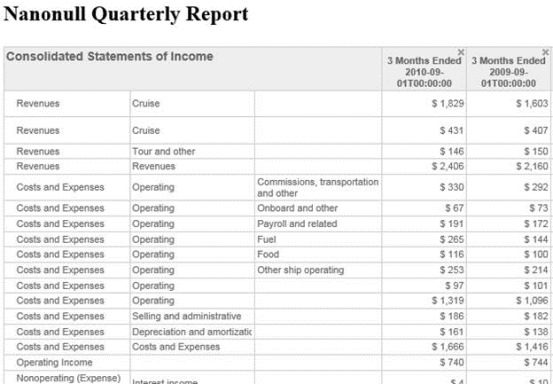Rendering XBRL Table Linkbases using StyleVision
StyleVision provides the ability to quickly and easily generate multichannel renderings and reports of XBRL data. Because it employs a visual, drag-and-drop design model and includes numerous XBRL-formatting wizards, even stakeholders without deep technical XBRL expertise can leverage the full power of standards-based XBRL data to generate rich business reports on a one-time or recurring basis. Starting with Version 2015 Release 3, StyleVision provides built-in support for rendering data according to XBRL Table Linkbase definitions. Let’s take a look at how it works.

What is XBRL Table Linkbase?
Though the presentation linkbase in a standard XBRL taxonomy allows taxonomy authors to define some basic presentation rules, it doesn’t allow for the presentation of the multi-dimensional XBRL data that is a basic requirement in financial reports used by accountants and other non-technical stakeholders. The XBRL Table Linkbase specification gives taxonomy authors the ability to define the structure of tables that display XBRL facts and relationships in myriad ways that combine dimensions, time period references, and more, all in a standardized way.
By standardizing the process of presenting XBRL data, table linkbases emphasize the advantages of XBRL for electronic transmission of financial data while providing added benefits for the human consumers of that same data. Since StyleVision is used to render XBRL reports, it makes sense that it be able to easily design reports around taxonomies that include XBRL Table Linkbase definitions.
Rendering XBRL Tables in StyleVision
If you want to take a look at a report based on an XBRL taxonomy that includes table linkbase definitions, open up the Nanonull.sps file that ships with StyleVision. To add a table based on an XBRL Table Linkbase, simply right click at the desired insertion point and select Insert XBRL Table from Taxonomy.
Then you can select the required table from the list of defined table linkbases present in the taxonomy.
Click OK, and StyleVision will generate the table in your report based on the layout defined by the table linkbase using data in the associated sample XBRL instance. (The sample instance is really for previewing your report as you work. You can use your .sps design to generate reports for any number of instances or on a recurrent basis, e.g., to generate quarterly reports. You can even automate the whole process using StyleVision Server.)
Here’s a snippet of the table selected above. I’ve simply added the header “Consolidated Statements of Income” and StyleVision has done the rest.

The layout defined by the XBRL Table Linkbase determines the X and Y axes, the order of aspect values, filtering of aspect values, and other information, and StyleVision generates the table based on this definition. However, should you wish to specify the table’s appearance manually, you can utilize the XBRL Table Wizard. The Table Wizard reads the table linkbase information and automatically fills its row and column breakdowns according to the definition of the selected table, and you can manually add them and arrange your table using drag and drop tools. Either way, utilizing information in XBRL Table Linkbase definitions makes it faster and easier to generate tables in StyleVision reports for the web or print in HTML, Word, or PDF.

XBRL Table Linkbase is supported across Altova’s XBRL-enabled products:
- XMLSpy: allows graphical definition of XBRL Table Linkbases in its XBRL Taxonomy Editor. Check out this video to see how to build and test an XBRL Table Linkbase definition.
- MapForce: data mapping tool for mapping XBRL to/from databases, Excel, and other formats
- RaptorXML+XBRL Server: hyper-performance server for XBRL validation
You can download a free, 30-day trial of these products on the Altova web site.


